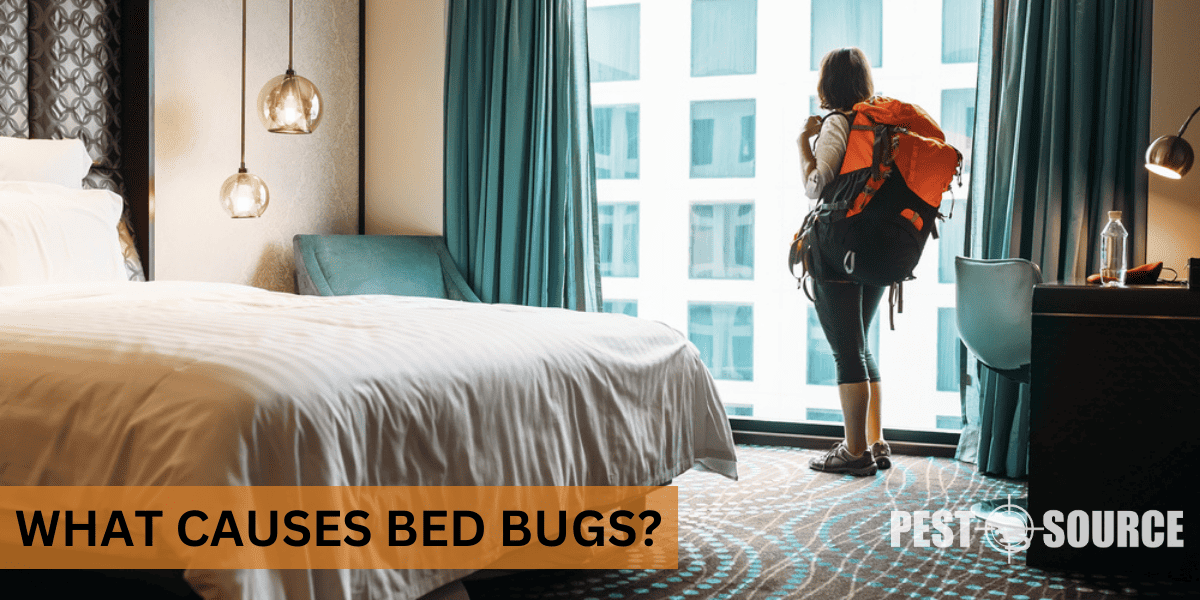Bed bugs are not caused by dirt or filth but are usually brought into a space via infested items like luggage, furniture, or clothing. They can also migrate between adjoining living spaces through small crevices. This article will explore common ways bed bugs enter homes and how to prevent an infestation.
POINTS
- Bed bugs are resilient pests that feed on human and animal blood, can easily hitch a ride on luggage, clothing, or personal belongings, and infest a wide range of environments, including homes, hotels, and public transportation.
- Common misconceptions about bed bugs include the belief that they are a sign of filth or poor hygiene and can only be found in low-income areas. In reality, bed bugs can survive in both clean and dirty environments as long as there is a food source available.
- Travel and purchasing used furniture are major factors contributing to the spread of bed bugs. Proper inspection of accommodations, handling luggage carefully, and scrutinizing second-hand furniture can help reduce the risk of infestation.
- Prevention and control of bed bugs involve a combination of thorough inspections, regular cleaning and laundering, using bed bug-proof encasements, and seeking professional pest control assistance when necessary.
- Completely eradicating bed bugs is difficult but not impossible with persistent efforts and vigilance in adhering to preventive measures. Consistent attention to potential signs of bed bugs and maintaining good practices can significantly reduce the likelihood of infestation in your home.
Origins and Reasons for Existence of Bed Bugs
What are bed bugs?
Bed bugs are small, flat, oval-shaped insects that feed on the blood of humans and animals. They are reddish-brown in color, usually about the size of an apple seed, and can be found in various types of environments, such as homes, hotels, and public transportation. They are mainly active at night and typically hide in places close to their food sources, such as mattresses, bed frames, and headboards.
Where do bed bugs come from?
Bed bugs can be traced back thousands of years, with evidence of them found in ancient Egyptian tombs. They are believed to have originated in caves, where they initially fed on the blood of bats. When humans began to inhabit caves, bed bugs found a new food source and started to infest human living spaces. Today, bed bugs are common and are found all over the world and have adapted to a wide range of environments, meaning they can be brought into homes and other buildings quite easily. More on where beg bugs come from.
Misconceptions about Bed Bugs
Do bed bugs come from filth or poor hygiene?
Contrary to popular belief, bed bugs are not attracted to filth or poor hygiene. They are only interested in one thing: a blood meal. Bed bugs can be found in both clean and dirty environments, as long as there is a food source – humans or animals – available to them. However, cluttered spaces can provide more hiding spots for bed bugs, which can make it harder to detect and treat an infestation.
What are the common misconceptions about bed bugs?
Some common misconceptions about bed bugs include the belief that they are a sign of a dirty, unkempt home or that they can only be found in low-income areas. Additionally, some people mistakenly think that bed bugs can jump or fly, leading to fears of them traveling long distances. In reality, bed bugs cannot jump or fly, but instead rely on crawling or hitching a ride on luggage, clothing, or other personal belongings to travel.
Why are there misconceptions about the causes of bed bugs?
Misconceptions about bed bugs can be attributed to a lack of knowledge, fear, and stigma associated with infestations. Many people are unaware of how bed bugs spread and how to prevent them, leading to false, and often unhelpful, assumptions about their origins. Additionally, the resurgence of bed bugs in recent years – after a period of decline – has led to a renewed interest and concern about these pests, with much misinformation being spread.
Understanding the Main Causes of Bed Bugs
What is the main cause of bed bugs?
The main cause of bed bugs is simply their need for a blood meal to survive and reproduce. Bed bugs are experts at finding ways to come into close proximity with humans or animals, as they rely on their host’s blood for sustenance. As hitchhikers, they can easily latch onto luggage, clothing, or other personal items and infest new locations.
What causes bed bugs in the first place?
Bed bugs, like all living creatures, exist because they are biologically designed to survive and reproduce. Their resilience, adaptability, and ability to evade detection have allowed them to thrive in various environments, including homes, hotels, and public transportation. Therefore, the existence of bed bugs isn’t caused by any one factor – their successful survival is the result of their biological and behavioral traits.
Why do bed bugs exist?
Bed bugs exist as part of the natural ecosystem. They have evolved over time and adapted to their surroundings in order to survive. While they may be viewed as pests to humans, they play a role in the food chain as prey for other insects and animals, such as spiders, ants, and even some birds. Their primary purpose is to feed, reproduce, and maintain their species’ survival, much like other living organisms.
How do Bed Bugs Spread?
Why do people get bed bugs?
People get bed bugs when the insects find their way into their living spaces in search of a blood meal. Bed bugs are adept at hitchhiking and are often transported unknowingly by people from infested locations to new environments. They can be brought into homes via luggage, clothing, used furniture, or even by crawling from an infested neighbor’s home.
How do people get bed bugs?
People can get bed bugs in their house in a number of ways, including:
- Travel: Staying in hotels, hostels, or other accommodations with bed bugs can lead to the insects hitching a ride on luggage or personal items, which are then brought back home.
- Used furniture: Purchasing second-hand furniture, especially mattresses and bed frames, can introduce bed bugs into a home.
- Close living quarters: In apartment buildings or shared housing, bed bugs can easily crawl from one unit to another through cracks, crevices, or even electrical and plumbing systems.
- Visiting infested locations: Spending time in infested homes, offices, or public transportation can result in bed bugs attaching to clothing or personal belongings, which are then transported to a new location.
Why do I keep getting bed bugs?
Recurring bed bug infestations can result from multiple factors, such as frequent travel to infested locations, repeated exposure to infested furniture or belongings, or insufficient treatment methods. Additionally, bed bugs are known for their resilience and ability to hide in difficult-to-reach places, making them difficult to fully eradicate. Identifying the source of the infestation and using thorough, effective treatments are key to preventing bed bug recurrence.
Bed Bugs and Travel
How does travel contribute to the spread of bed bugs?
Travel is a significant contributor to the spread of bed bugs because these pests are excellent hitchhikers. They can easily crawl into suitcases, backpacks, or other personal belongings in infested hotel rooms, hostels, or vacation rentals. When travelers return home or move on to another location, they unwittingly transport the bed bugs, introducing them to new environments.
Why do I keep getting bed bugs after traveling?
If you consistently get bed bugs after traveling, it’s likely that you are staying in or visiting infested locations during your trips. Bed bugs can easily latch onto your luggage, clothing, and other personal items, allowing them to travel with you and infest your own home. To minimize the risk of bed bugs after traveling, it’s essential to inspect your accommodations for signs of bed bugs, store your luggage off the floor, and thoroughly check and launder your belongings upon returning home.
The Role of Second-Hand Furniture in Bed Bug Infestations
Why does buying used furniture increase the risk of bed bugs?
Purchasing second-hand furniture increases the risk of bed bugs because these items may already be infested with the pests. Bed bugs can hide in the seams, crevices, and folds of furniture, particularly in mattresses, box springs, and bed frames. When you bring infested furniture into your home, you introduce bed bugs to a new environment.
What should be done when buying used furniture to prevent bed bugs?
To prevent bed bugs when buying used furniture, follow these steps:
- Inspect the furniture thoroughly before purchase: Look for live or dead bed bugs, as well as signs of them, such as fecal spots, shed skins, and eggs.
- Ask the seller about any history of bed bug infestations in their home.
- Consider avoiding common bed bug hiding spots, such as upholstered items or mattresses, when purchasing second-hand furniture.
- Once the furniture is in your home, clean and sanitize it thoroughly, paying close attention to seams, folds, and crevices.
- If you still have concerns, consider contacting a professional pest control company to inspect and treat the furniture before bringing it into your home.
Bed Bugs in Residential Areas
How do bed bugs spread from home to home?
Bed bugs spread from home to home by crawling through shared walls, vents, electrical conduits, or plumbing in multi-unit residential buildings, such as apartments and condominiums. They can also be inadvertently transferred between homes by visitors, moving trucks, and shared laundry facilities.
Why do you get bed bugs when living in close proximity to someone who has them?
Living in close proximity to someone with a bed bug infestation increases the chances of the pests spreading to your home. In shared living spaces, such as apartment buildings or dormitories, bed bugs can crawl from one unit to another through shared walls, plumbing, or electrical systems. They can also be transported on people’s clothing, luggage, or personal belongings.
What causes a bed bug infestation in residential areas?
A bed bug infestation in residential areas can be caused by a variety of factors, including:
- Proximity to infested locations: Living near hotels, hostels, or other high-risk environments increases the likelihood of bed bug exposure.
- High population density: Bed bugs thrive in densely populated areas where there are more human hosts available to feed on.
- Increased travel: People who frequently travel to and from infested locations may inadvertently bring bed bugs back to their own homes.
- Second-hand furniture: Purchasing used furniture from an infested source can introduce bed bugs into a residence.
- Ineffective pest control measures: Bed bugs are resilient pests that can be difficult to eliminate without proper treatment measures.
Prevention and Control of Bed Bugs
How can the spread of bed bugs be prevented?
Preventing the spread of bed bugs requires vigilance and proactive measures, such as:
- Regularly inspecting your home for signs of bed bugs, including checking mattresses, bed frames, and headboards.
- Laundering bedding, curtains, and clothing frequently, as well as using high heat settings on your washer and dryer to kill bed bugs and their eggs.
- Encasing your mattress and box spring in bed bug-proof covers to eliminate hiding places and provide an extra layer of protection.
- Avoiding clutter, as it provides more hiding places for bed bugs and makes it difficult to detect and treat an infestation.
- Being cautious when purchasing used furniture, as well as thoroughly cleaning and inspecting it before bringing it into your home.
- Following proper travel precautions, such as inspecting hotel rooms, storing luggage off the floor, and examining your belongings for bed bugs upon returning home.
How to handle a bed bug infestation?
Handling a bed bug infestation requires a combination of both non-chemical controls and, if necessary, professional pesticide treatments. To manage an infestation:
- Thoroughly inspect your home to identify where bed bugs are hiding and the extent of the infestation.
- Remove and launder infested bedding, clothing, and curtains using hot water and/or a high-heat dryer setting to kill bed bugs and their eggs.
- Vacuum your home extensively, paying close attention to cracks, crevices, and other potential hiding spots. Dispose of the vacuum contents in a sealed plastic bag.
- Encase your mattress and box spring in bed bug-proof covers to trap any remaining insects inside and prevent their escape.
- Seek help from a professional pest control company, if necessary, to apply pesticide treatments and ensure complete eradication of the infestation.



